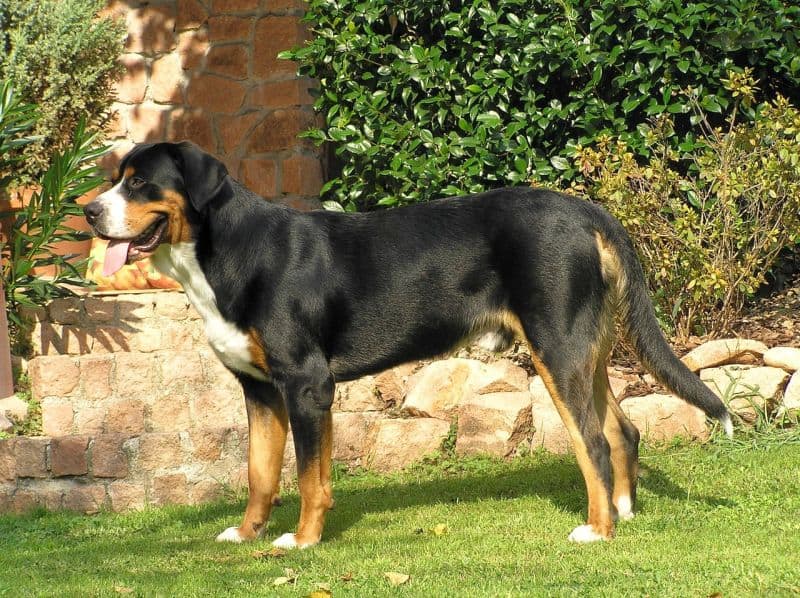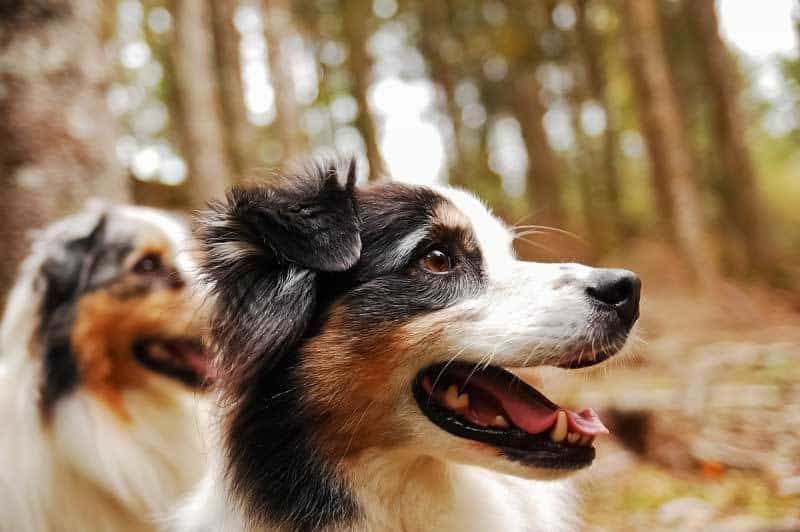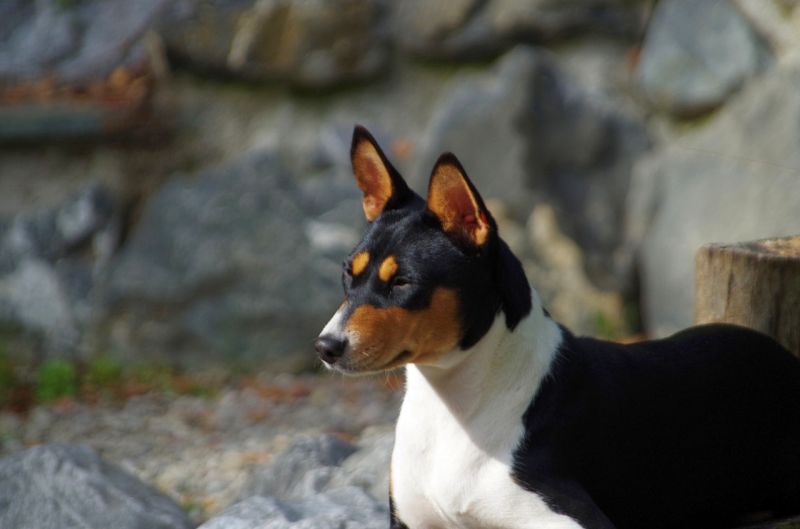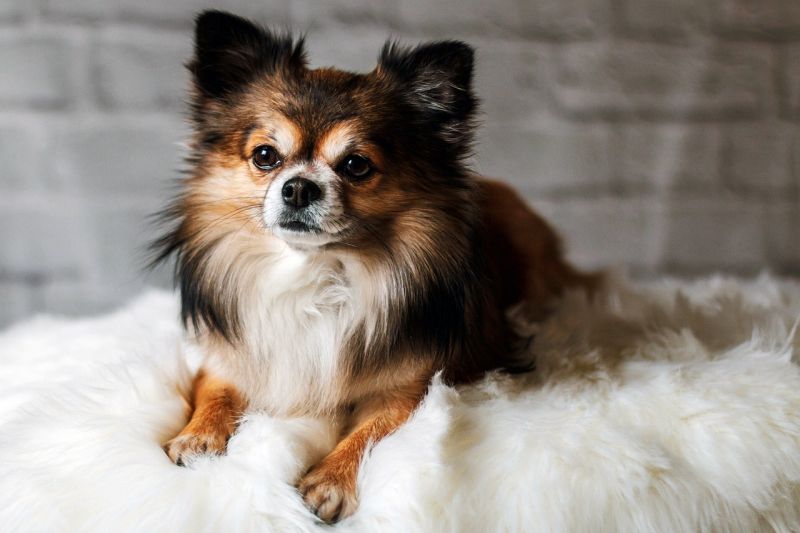As striking as it is adorable, the tricolor coat pattern is one of the most common color schemes in dogs. This classic combination generally consists of black, white, and brown, though a mix of any three colors technically fits the definition.
Like brindle, spotted, and other coat patterns, the tricolor color scheme is found among many dog breeds.
It may consist of a classic color-block look, in which the colors are largely confined to a few key areas (as seen in Bernese mountain dogs), or it might get a little crazy with color splotches spread out all over the place, as occurs in some panda shepherds.
Let’s explore 15 of the coolest tricolored dog breeds out there and talk about some of the neatest things about them below.
1. Entlebucher Mountain Dog

A medium-sized breed and a member of the herding group, the Entlebucher comes in the traditional color-block tricolor pattern with a white chest blaze, a mostly black body, and brown markings — two of which resemble expressive eyebrows.
The Entlebucher may not be well-known outside of the dog show world, but this doe-eyed cutie deserves your attention with his striking good looks and a heart to match.
Entlebuchers are a hardworking breed that thrives with a job to do, so if you’re a couch potato, he isn’t the dog for you. Because of his high energy levels and strong will, the Entlebucher isn’t ideal for first-time dog owners, either.
The Entlebucher is easy to groom, however, thanks to his short coat, and he is extremely loyal to his family.
2. Beagle

Easily the most recognizable tricolor cutie is the beagle, a small hound who makes an excellent family friend. He’s a happy-go-lucky pup with a distinct bark known as a bay, and he isn’t afraid to let you know how he feels by using it.
Originally bred for hunting in packs, the beagle is a dog-friendly scenthound who follows his nose, though the latter may lead to him wandering off, so never trust him off-lead.
Beagles come in a kaleidoscope of colors, with a whopping eleven coat patterns meeting the AKC standard — six of which are variations of tricolor!
His short coat is easy to care for, though he does shed moderately year-round. Beagles require daily exercise, and as one of the breeds most prone to separation anxiety, careful attention should be taken when he’s alone to prevent destructive behavior.
3. Bernese Mountain Dog

The Bernese mountain dog, or Berner for short, is a heavily built working breed with calendar-worthy cuteness.
He may be strong, but he’s famously gentle, making him an excellent companion for children.
But because he is a big pooch, early training is essential for controlling his worst puppy instincts before he gets too large to handle.
Berners have a dense coat with a long outer layer that is prone to tangles, so frequent brushing is a must. This beautiful coat means he’s a cold-weather natural, however, and he isn’t afraid of getting his snowdog on when winter comes.
As a working breed, he requires moderate daily exercise, and cart pulling is a popular sport among breed fanciers.
4. Basset Hound

If you’re a fan of low and slow, you’ll adore the basset hound.
He’s a mellow pup with old-soul charm, and his big-dog bay surprises many because of his short stature.
The basset can be difficult to train, and as a scent hound, he will follow his nose, so make sure he is on a lead at all times when he’s not in a fenced-in area.
Grooming a basset is a breeze because of his short coat, but special care is needed in cleaning his ears, as he is prone to ear infections.
As a treat hog and infamous couch potato breed, he has a tendency to pack on the pounds easily, so a daily walk is a good idea to keep his weight in check.
5. Bull Terrier

A clownish cutie with a potato-shaped head, it’s hard not to love the bull terrier. He’s well-known for his playful antics and joyful spirit, earning him a spot as a beloved family dog.
If you’re not a fan of frequent grooming, the bull terrier is right up your alley, as a weekly bath and brushing is all he requires to stay clean and looking his best.
The bull terrier benefits from training at an early age, as his thirst for fun can be a challenge as he grows, leading to weak impulse control that’s hard to manage in such a strong breed.
He needs moderate exercise daily, with a long walk or jog sufficing, as well as plenty of durable chew toys, as these pooches love to gnaw.
6. Pit Bull

Pit bulls come in many coat patterns, including tricolor. Maintaining his good looks is easy, as his short hair only requires an occasional brushing. He sheds moderately year-round, however, so keep your vacuum handy.
As a powerful breed with muscles for days, your pit bull should start training as soon as possible. He may look tough, but he’s a softie at heart, so remember to keep training happy and upbeat.
Pit bulls are high-energy pups that need daily exercise, so keep tennis balls and toys handy. Harnessing his strength and energy in a positive way through a sport like rally or dock jumping is ideal, though he’s just as happy to be your jogging buddy.
7. Pomeranian

A sassy spitz with plenty of personality, the Pomeranian comes in many colors and patterns, including tricolor.
The Pom’s fuzzy coat gives him a teddy-bear look, though upkeep is tricky with frequent brushing needed to avoid matting.
You should also brush his teeth weekly to prevent dental issues, which are a common problem in toy breeds.
Pomeranians are natural-born entertainers with lively demeanors. Poms are happiest when they’re with their owners, and as a breed that easily doubles as a lapdog and an adventure buddy, don’t be afraid to look into agility trials for your Pom pupper.
While Poms are sweet and affectionate, they’re not recommended for homes with children due to their fragile nature.
8. Papillon

Named for their butterfly-like ears, the papillon is a toy breed with an exuberance for life.
If you want a small dog that is still an all-star at so-called big dog sports like agility, check out the Papillon.
He’s highly trainable with a desire to please, and he’s an easy keeper too — only requiring a moderate amount of exercise you can achieve with a walk and indoor play.
While his coat is gorgeous, don’t be tricked into thinking it needs extensive upkeep. He lacks the undercoat of many other breeds, meaning a weekly combing to avoid tangles is sufficient. This lack of fur does have a downside, however, as he doesn’t do well in cold weather.
9. Greater Swiss Mountain Dog

Greater Swiss mountain dogs look a lot like short-haired versions of the Bernese mountain dog, and in a lot of ways, the two breeds are similar.
If you’re seeking a gentle giant, the Swissie (as they’re often called) might be the dog for you.
He’s large and powerful but still makes an incredible family dog with his affectionate nature. Starting training early with your Swissie is a must, as he will quickly become too large to handle if he’s unruly.
Despite his working background, his daily exercise needs are only moderate, with a long daily walk or hike enough to keep him happy. With his droopy jowls, this is a slobbery pooch, so if you’re not big on drool, keep looking.
10. Australian Shepherd

Australian shepherds (or “Aussies” as they’re often known) are the chameleons of the dog world with their multitude of colors and patterns, including tricolor and merle.
They’re just as versatile when it comes to sports, as they excel in seemingly everything from obedience to herding. Active people rejoice — this is the dog of your dreams as Aussies demand daily exercise and are incredible jogging companions.
The Aussie’s thick, medium-length coat requires weekly brushing, though this increases as shedding season arrives. During these times of coat “blowing,” you should brush your Aussie every other day to strip the shedding undercoat.
11. Pembroke Welsh Corgi

While the tricolor look doesn’t meet the AKC breed standard, it is commonly seen in the Pembroke Welsh corgi.
The Pembroke Welsh corgi is a fun and lovable breed, who is easy to distinguish from his Cardigan brother by his lack of a tail. But don’t worry — he’s just as affectionate and eager to please.
Despite his short legs, he excels at herding and agility and has quickly sprung toward the top of the popularity charts.
He’s a natural member of your family with his friendly personality, and his clownish mannerisms make him an excellent therapy dog. A Corgi is your perfect match if you love to play, as he’s always waiting for the next ball to chase.
12. Basenji

The basenji is an expressive hound with a mind of his own. He’s surprisingly catlike with his dislike of water and fastidious grooming, but he has a doggish zest for fun and adventure.
His “barkless” label may catch your eye, but that doesn’t mean he is silent. In fact, the breed makes a variety of noises like yodels, chirps, and even screams.
The basenji is not a dog for first-time owners, as he is as stubborn as he is handsome.
He’s naturally inquisitive and energetic, so you can expect lots of mischief from this clownish cutie. His independent ways benefit from early training, and as he grows, lure coursing and agility provide healthy outlets for his abundance of energy.
13. Chihuahua

Tiny and tenacious, the Chihuahua may be short in stature, but he has a huge personality to make up for it.
He’s incredibly loyal to his master, and he is the king of lapdogs, but his stubborn side can be a challenge for first-time dog owners.
He only weighs up to 6 pounds, so he is too delicate for a household with rough-and-tumble larger dogs or children. Nevertheless, he’s a saucy pup with loads of energy, though his exercise needs can be easily met with a daily walk and indoor play.
Chihuahuas are one of the longest-lived breeds out there and are generally healthy aside from dental or eye disease.
14. Collie

Both rough (long-haired) and smooth collies come in tricolor flavors, with three of the ten breed standard coat colors fitting the label.
A Hollywood favorite thanks to Lassie, the collie is a herding breed that is renowned for trainability.
He’s high energy and eager to please, making him an excellent candidate for agility and obedience. He is sensitive, however, so you should only use positive training methods.
Rough collies have a long, thick coat that requires regular combing to prevent matting, while Smooth collies also need brushing to remove the dense undercoat as it sheds. Both varieties shed heavily once a year.
It is important to note that some collies are sensitive to a few common medications, so it is imperative that you contact your vet before giving him any medicine. Health screenings are also important to detect potential eye problems in the breed.
15. Panda Shepherd
The panda shepherd is a German shepherd dog with a color mutation that makes them appear tricolored. While the coat pattern doesn’t meet the breed standard, it’s adorable and paired with the breed’s trademark big ears, it gives the usually-serious breed a playful look.
Panda Shepherds’ tricolor look is typically more spotted or ticked than other breeds on this list, but this extra-special look makes him one of a kind.
Since he is a working breed at heart, he needs daily physical and mental exercise. You should enroll your panda shepherd in obedience and socialization classes early, and it wouldn’t hurt to consider a sport like agility for him to burn off his energy as he grows.

If you love the look of this cutie, just know that the panda shepherd sheds moderately every day, with two seasonal bursts of heavy shedding in spring and fall.
***
Do you have any of these tricolored breeds at home? What about a different tricolored cutie? Let us know in the comments.








8 Comments
January 3, 2022
Hi! How can I identify the breed of my dog? She looks like a Pitbull mixed with a Beagle but I’m not sure exactly. Can I upload a picture of my dog and get feedback on what kind of dog she is?
Thank You!
KJB
January 3, 2022
Hey there, Kevin.
You’re welcome to share a photo of her with us via our uploader, but no one can positively identify a dog based solely on appearance.
To know with certainty, you’ll need to pick up a doggie DNA test.
Thanks!
August 14, 2021
This dog has white black brown and golden on its eye and my dad found it on the road and we want it to keep it is very small but we are wondering what kind of dog it is?
August 16, 2021
The only way to know for sure is to perform a dog DNA test, Nevaeh.
Best of luck!
June 2, 2021
Hello. The photo of the panda Shepherd is a photo I took of my dog Riot years ago. You do not have permission to use it. I respectfully ask that you remove it – there are plenty of panda owners that would love to provide a free image for you
Also, panda is not piebald. It is very different which is important. I wouldn’t mind you using my photo so much if it wasn’t used to spread misinformation. The panda gene is more similar to tobiano in horses than it is piebald.
June 2, 2021
Hey there, Quin.
No problem about the photo — I’ve removed it. It looks like you’ve taken it down from Imgur, so I can’t double-check, but I’m pretty sure it was listed under a CC when we used it.
At any rate, sorry about that!
Not sure we agree that the term “piebald” is incorrect here though, as we used it as an adjective — not in reference to a specific mutation. And “spreading misinformation” is a bit harsh.
Nevertheless, we’ll tweak that language to avoid confusion.
Everything else aside, Riot sure is a cutie!
🙂
February 9, 2021
should’ve included pics
February 9, 2021
Hey, Steven.
We did have photos of all those dogs, but we ran into a technical issue.
I’m working on replacing them now.